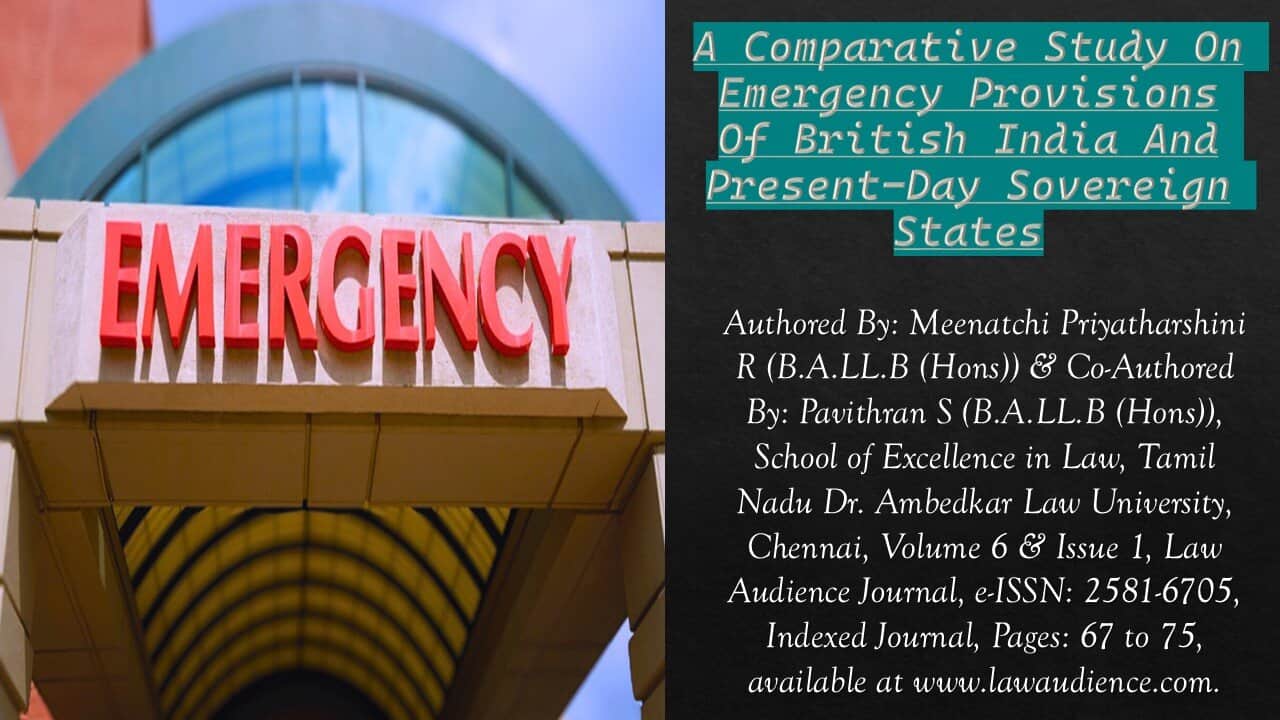Click here to download the full paper (PDF)
Authored By: Meenatchi Priyatharshini R (B.A.LL.B (Hons)) & Co-Authored By: Pavithran S (B.A.LL.B (Hons)), School of Excellence in Law, Tamil Nadu Dr Ambedkar Law University, Chennai,
Click here for Copyright Policy.
ABSTRACT:
“The concept of Emergency provisions in a state is a prior guideline for the state to do its fullest in cases of emergency. Very obviously, there can be no rights safeguarded in such a grave situation because the ultimate aim of the sovereign would be to save the lives of their subjects. Such a grave situation could be both internal as well as external. And essentially, it need not be only a war. A state with a long-established administrative history would be able to give their best but countries which were newly formed after the huge wave of de-colonization such as India, Pakistan and Bangladesh, still have their traces back to the British rules. The then existed British Administration’s Government of India Act, 1935 is applicable for the entire British Raj, which are the present day, India, Pakistan and Bangladesh. Though the British India has been partitioned, their Constitution still have a uniting thread with regard to their language and their emergency model. This article gives a brief comparison of these countries’ emergency provisions with that of the Government of India Act, 1935. By this the impact of the British rules in these absolute Sovereign states are analyzed”.
Keywords: Emergency Provisions, Indian Emergency laws, Pakistan, Bangladesh, Government of India Act, 1935.
I. INTRODUCTION:
The then British India comprised of present day, India, Pakistan and Bangladesh, in 1935. Earlier to 1935, the territories under British India was much larger and it comprised of several territories that India was partitioned seven times, including the partition of Pakistan at the time of Independence, in 1947. When British enacted the Government of India Act, 1935, it very clearly separated Burma and Aden from British India and made them as separate colonies. The Government of India Act, 1935 had sections which clearly set up the federal government in the British India with the Governor-General as the head of the Federal government and the Governor as the head of the Provincial Government and their both were advised by a council of minister and they were expected to report to the Secretory of State whom, represents the British India in London. The Government of India Act, 1935 also set up the bicameral legislations in both the levels of Governments. There were provisions for Federal as well as provincial emergencies in sections 45, 93 and 102. The point to be noted is that the Act only gave provisions for government’s structure and function, it didn’t give any Fundamental Rights and duties as have in our present-day Constitution of all three countries. (Jain M. , 2018)
India, after independence, had a lengthy series of Constitutional Assembly for drafting a suitable Constitution for the country and in it, they have analyzed the merits and demerits of the provisions of emergency, and they have finally concluded with the Part XVIII of the Indian Constitution. In case of Pakistan, they become an independent country along with India and have attained the status of republic in 1956, with their first Constitution. But they came to a settled constitution in the year 1973, after the partition of East and West Pakistan. Bangladesh as well came up Constitution in the same year but they, inserted emergency provisions through their second amendment only. But, till 1956, both these countries were administered under the Government of India Act, 1935. Let us have a comparative analysis of the present-day provisions of these three countries, with that of the Government of India Act, 1935, with regard to the model of emergency followed, the types of emergencies acknowledged, the grounds of emergency, time bound nature of the emergency, and the powers vested on the Sovereign authority in these federal states.
II. JUDICIARY’S ROLE:
Emergency models are based on, on whom the entire administrative powers of the entire country are vested upon. In that way, all these countries in it’s present-day Constitutional set up, has vested the vested upon the federal or the union government, which is a neo-roman model, whereby the President and the union legislature are given supreme power during emergency. (Jain S. , 2000)
II.I JUDICIAL REVIEW:
In Pakistan, they have explicitly, excluded the judiciary’s intervention through its Art 236, whereby, there can be no questions posed on the orders and proclamations issued during emergency in any court of law. In India, the 38th Amendment brought in this feature and by impact of which, there were various cases, in which the judiciary was expected to tie its own hands even when, right to life was infringed in the infamous case of Habeas Corpus case during the internal emergency imposed in 1975. Emergency was to be issued for a grave situation, but 1975 emergency in turn lead to another grave situation. Judiciary being a safeguard for the Indian Constitution and Fundamental Rights of people, excluding such a review power of the judiciary would not be a human right violative move and it is very evident in the case of 1975 emergency in India. But, for that, in highly populated countries like India, the people jury system, which is present in Vatican City, could also be not incorporated. Because, it would put a burden upon the Government which is practically not possible to be achieved easily, as satisfying these crores of people would be merely impossible. Fortunately, the 44th amendment in Indian Constitution, removed the clause which excluded the judiciary’s barrier to do judicial review of the legal validity of the proclamation but not with regard to the adequacy of grounds of the proclamation issued. The Bangladesh Constitution is not explicitly speaking anything about the non-intervention of the judiciary during proclamation. Meanwhile, the entire executive power is vested upon the President and the entire Legislative power upon the Parliament, even on subjects exclusively under the state or provincial list. This power does not entitle the President or the Parliament to take up the powers of the judiciary or suspend their powers. (RAJU, 1991)
II.II ENFORCEMENT OF FUNDAMENTAL RIGHTS:
All these countries uniformly have a, whereby, during emergency, the right to move to court for the enforcement of the Fundamental Rights of the people are suspended. Not all the Fundamental Rights but certain specific rights as per the order issued by the President during National Emergency. At the same time, the common feature as to this suspension is that this can be extended to the whole of India or any part thereof, and it has to be laid before the Parliament for its approval. This provision is missing in the Government of India Act, 1935, as the act did not have any relevance to the Fundamental Rights of people. India, out of its practical experiences has, explicitly mandated the President to not suspend Article 20 and 21 even during emergency. This makes clear that, though the Union government is vested with supreme power during emergency, it is also provided with this limited power and it is necessitated. Apart from this, the right to freedom of movement, right to form assembly, associations, freedom of speech, expression and thoughts, are explicitly automatically suspended at once, National Emergency on the grounds of war or external aggression or internal disturbance or armed rebellion as been issued, as the case may be. Here, the statement of Krishna Ayyar in Constitutional Assembly of India is noteworthy of mentioning – ‘war cannot be fought on principles of Magna Carta’. Here, it doesn’t mean that emergencies are declared only due to war. (Rao, 2010)
III. TYPES OF EMERGENCIES AND THEIR GROUNDS:
III.I NATIONAL EMERGENCY:
Continuing with the grounds of emergency, in case of National Emergency, the three basic grounds found in three countries are,
- War
- External Aggression
- Internal disturbance (Armed rebellion in case of Indian Constitution)
The Government of India Act, 1935 gives provisions for the existence of war or internal disturbances only, under section 102. Apart from this, under section 45, there can be proclamation made in case where the federal government has failed to act in accordance with the provisions of the said Act. This section is a product of the fact that, British India then, was not a sovereign territory and the fact that today these three countries have sovereignty, this provision could have been not included. The Indian Constitution framing committee came up with words such as internal violence or domestic violence for the word internal disturbance. This very clearly explains the aggressiveness involved in the term ‘internal disturbance’. Yet, the 44th amendment, to make it very explicit, changed the ground from internal disturbance to armed rebellions. This was also defined beyond doubt by the judiciary in Bommai case, where Emergency on the grounds of armed rebellions could be imposed in such a situation where, the state government is not able to manage it by itself. (Basu, 2019)
In case of Pakistan, it has made it very explanatory by stating internal disturbance beyond the power of the provincial government. As well as the Constitution mandates a resolution passed by the province’s legislature for proclamation of emergency under the grounds of internal disturbance. The hardened definition of internal disturbance, has limited the powers of the federal or the union government so that this extreme power could not be misused for their political gain. This substantiates the federal feature of the Constitution. The need of prior resolution that is in need to be passed by the provincial legislation in Pakistan, to some extend might also cause delay in addressing the emergency. The Government of India Act, 1935 and Pakistan’s Constitution, mandates the actual existence of the said grounds for the proclamation of emergency, whereas, in India and Bangladesh, instead of actual existence of the grounds, there can be an imminent danger of the said grounds. The component of satisfaction of the Governor-General was not necessitated whereas, the other developed countries have mandated the satisfaction of the President necessary, and the adequacy of the satisfaction cannot be question in any court of law but its malafide intention can be, but even this is completely excluded in Pakistan.
III.II STATE EMERGENCY:
In case of failure of the state or the provincial government to act in accordance with constitution, there are provisions for issuance of proclamation in the Constitution of India, Pakistan and Government of India Act, 1935. The Government of India Act, 1935 gave a huge power over the Governor, whereby, under section 93, he may issue proclamation for a period of 6 months. And if approved by the Parliament, it might extend for a further period of 12months, if he is satisfying that the province is not acting in accordance with the Constitution. During emergency, exempting the powers of High Courts, he is vested with all other powers of the executive and legislature of the province. This huge power vested upon the Governor is reduced whereby, the Governor can only send a report for issuance of proclamation to the President, on receipt of which, the President would issue proclamation and here also, the union or the federal government takes up the power of the state or provincial government, excluding the powers of High Court, in India and Pakistan. Apart from, there is insertion of Financial Emergency in India and Pakistan.
IV. ANALYSIS AND SUGGESTIONS:
Apart from the above discussed grounds, types and power distribution in case of emergency, there were notable changes in time duration for the cessation of the proclamation and the time period for which the laws enacted in violation of Fundamental Rights would exist. The earlier Government of India Act, 1935, under section 102, gave cessation period of 6 months, if the proclamation has not obtained the approval of the Parliament. Under section 45 and 93, the proclamation would extend for a period of a one year on approval of the Parliament apart from the prior 6 months, and so, it totally amounts to 1.5 years which is a very lengthy period for a single proclamation. But it has been reduced in all the three countries to 1 month, 2months and 120 days, if approval of the Parliament is not obtained in India, Pakistan, and Bangladesh respectively. Having all these rules and conditions on one side, the ultimate aim of these rules and regulations are to state the fact that the Constitution would retain its federal feature excepting an extraordinary situation, where the unitary features would come into play, as explained by Dr. B R Ambedkar. Though we have these many rigid procedural rules and regulations (like need of resolution being passed in Parliament, not exempting the judicial review, etc., as the case may), and though we segregate emergency as whether it is national or state or financial emergency, there must be separate provisions addressing the situations of war, external aggression, internal disturbance or armed rebellion, and failure of government to abide by constitutional provisions. Because, in no case, an external aggression be equated with that of an internal disturbance because, there might be much more political and social factors involved in the later. Thus, following a same procedure for the both would not be proper. When the internal disturbance is more concentrated in a particular state, it might go hand in hand with the state emergency, where the report of the Governor on the current status of society might be needed. Thus, instead of grouping these grounds, there could be separate provisions for each ground.
V. CONCLUSION:
Thus, there is an express footprint of the Government of India Act, 1935 in the Constitutional provisions of these three countries and there is no wonder in this. But still, looking into the terminologies of these emergency provisions, they do not seem easy to understand. We have evident usage of these provisions for the political usage of people in power. The language of these provisions could be made simple such that any literate who knows the language could understand. The legal language of the profession has to be maintained, yet if the same is going to be a hinderance of the aim of the law, i.e., to do justice for people, then, such a complicated way of expression could be made explanatory. Comparing all the three Constitution with that of Government of India Act, 1935, gives different procedures followed in these countries, whereby the concept of Constitutional Dictatorship is invoked with constitutionalism. When their language is made easier, it might further increase the comparing and contrasting scope of the emergency to build strong rules with balances human rights protection and imposition of power by the sovereign over the subjects.
Cite this article as:
Meenatchi Priyatharshini R & Pavithran S, “A Comparative Study on Emergency Provisions Of British India And Present-Day Sovereign States” Vol.6 & Issue 1, Law Audience Journal (e-ISSN: 2581-6705), Pages 67 to 75 (10th June 2025), available at https://www.lawaudience.com/a-comparative-study-on-emergency-provisions-of-british-india-and-present-day-sovereign-states/.
References:
Basu, D. D. (2019). Introduction to Constitutional of India (24 ed.). LexisNexis.
Datar, A. P. (2010). Commentary on the Constitution of India (2 ed.). Nagpur: LexisNexis.
Jain, M. (2018). Constitutional Law (8 ed.). LexisNexis.
Jain, S. (2000). The Constitution of India, A Commemorative Edition on 50 years of Indian Constitution. New Delhi: Taxmann.
Pylee, M. V. (2010). Constitutional Amendments in India (3rd ed.). New Delhi: Universal Law Publishing Co. Pvt. Ltd. .
RAJU, K. H. (1991). Dr. B. R. AMBEDKAR AND MAKING OF THE CONSTITUTION: A Case Study of Indian Federalism. The Indian Journal of Political Science, 52(2), 153-64. Retrieved July 17, 2023, from http://www.jstor.org/stable/41855548
Rao, B. S. (2010). The Framing of India’s Constitution, A Study (2 ed.). (C. K. Dr. Subhash, Ed.) Delhi: Universal Law Publishing Co. Ltd, Pvt.
Refered Acts:
- Constitution of India, 1950
- Constitution of Pakistan,1973
- Constitution of Bangladesh, 1973
- Government of India Act, 1935



